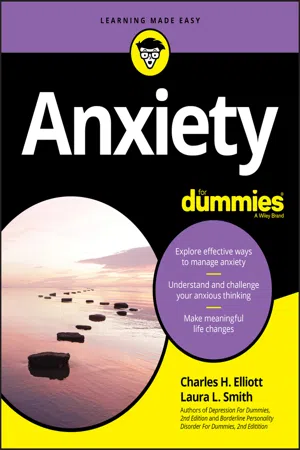
- English
- ePUB (mobile friendly)
- Available on iOS & Android
Anxiety For Dummies
About This Book
Take control of your anxiety—and start living your life
Feel like your life is spinning out of control? Not sure how to handle what seems like constant change and chaos? You're not alone—the world has taken some pretty crazy turns recently—but if you suffer from an anxiety disorder, you're likely suffering far more than you need to. Anxiety is our natural reaction to unfamiliar, stressful, and dangerous situations, but for some of us this reaction can become all-consuming and ultimately debilitating. Anxiety For Dummies has the antidote to this, showing you how to manage feelings of uneasiness, distress, and dread—and take back control of your life.
In a straightforward and friendly style, clinical psychologists Charles H. Elliot and Laura L. Smith show you how to pinpoint your triggers, use proven techniques and therapies, improve health and eating habits, and make other practical changes to your lifestyle that will have you feeling better fast.
- Understand what makes you anxious and learn to let go
- Change your thinking to "right-size" your worry
- Evaluate self-help as an adjunct to professional therapy
- Explore healthy lifestyles and medication options
Including updates to the clinical literature and discussions of the impacts of world events—such as COVID-19—this book has everything you need to manage your worries and put you, not them, in charge of your life.
Frequently asked questions
Information
Detecting and Exposing Anxiety
Analyzing and Attacking Anxiety




Anxiety: Everybody’s Doing It
- When my panic attacks begin, I feel tightness in my chest. It’s as though I’m drowning or suffocating, and I begin to sweat; the fear is overwhelming. I feel like I’m going to die, and I have to sit down because I may faint.
- I’ve always been painfully shy. I want friends, but I’m too embarrassed to call anyone. I guess I feel like anyone I call will think I’m not worth talking to. I feel really lonely, but I can’t even think about reaching out. It’s just too risky.
- I wake with worry every day, even on the weekends. Ever since I lost my job, I worry all the time. Sometimes, when it’s really bad, I feel like I’m going crazy, and I can’t even sleep.
- I’m so afraid of everything that I can barely leave the house. I’ve stopped even looking for jobs. My family has to bring me groceries.
Tabulating the Costs of Anxiety
What does anxiety cost you?
- A physical toll: Higher blood pressure, tension headaches, and gastrointestinal symptoms can affect your body. In fact, recent research found that certain types of chronic anxiety disorders change the makeup of your brain’s structures.
- A toll on your kids: Parents with anxiety more often have anxious children. This is due in part to genetics, but it’s also because kids learn from observation. Anxious kids may be so stressed that they can’t pay attention in school.
- Fat: Anxiety and stress increase the stress hormone known as cortisol. Cortisol causes fat storage in the abdominal area, thus increasing the risk of heart disease and stroke. Stress also leads to increased eating.
- More trips to the doctor: That’s because those with anxiety frequently experience worrisome physical symptoms. In addition, anxious people often worry a great deal about their health.
- Relationship problems: People with anxiety frequently feel irritable. Sometimes, they withdraw emotionally or do the opposite and dependently cling to their partners.
- Downtime: Those with anxiety disorders miss work more often than other people, usually as an effort to temporarily quell their distress.
The cost to society
Recognizing the Symptoms of Anxiety
Table of contents
- Cover
- Title Page
- Table of Contents
- Introduction
- Part 1: Detecting and Exposing Anxiety
- Part 2: Battling Anxiety
- Part 3: Letting Go of the Battle
- Part 4: Zeroing in on Specific Worries
- Part 5: Helping Others with Anxiety
- Part 6: The Part of Tens
- Appendix: Resources for You
- Index
- About the Authors
- Advertisement Page
- Connect with Dummies
- End User License Agreement